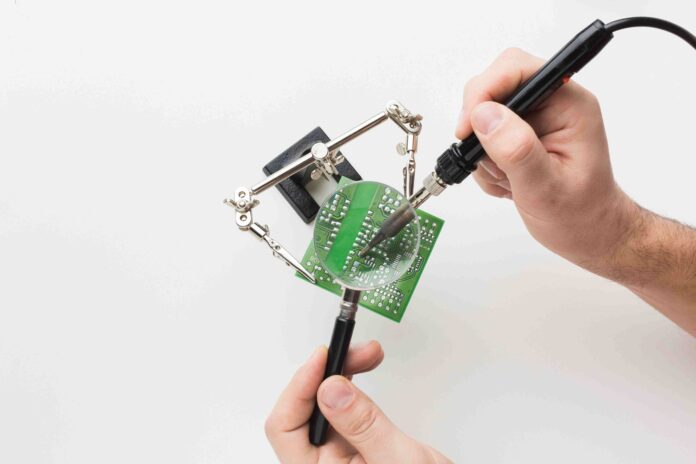The electronics industry is constantly evolving, driven by advancements in technology and an ever-growing demand for high-quality products. At the heart of this evolution lies Printed Circuit Boards (PCBs), which serve as the foundation for most electronic devices. From smartphones to medical equipment, PCBs are essential components that bring electronic circuits to life. One of the most transformative technologies in PCB assembly is the pick-and-place machine, which has significantly improved efficiency, accuracy, and scalability in the manufacturing process. In this article, we will explore how pick-and-place machines are revolutionizing PCB assembly, touching on key related topics such as PCB design, PCB prototyping, surface-mount technology (SMT), and automation in manufacturing.
Understanding Pick-and-Place Machines
A pick-and-place machine is an automated piece of equipment used in the PCB assembly process to place electronic components onto the board with precision. These machines are capable of handling thousands of components per hour, ranging from small resistors and capacitors to integrated circuits (ICs) and other complex parts. The process involves:
- Picking up components from reels, trays, or feeders.
- Precisely positioning them onto the PCB according to the design specifications.
- Preparing the assembly for further processes like reflow soldering or wave soldering.
Modern pick-and-place machines are equipped with advanced vision systems, robotics, and software that ensure unparalleled accuracy and speed. These capabilities make them indispensable in mass production and prototyping environments.
The Role of PCB Design in Pick-and-Place Efficiency
Efficient PCB design plays a critical role in optimizing the performance of pick-and-place machines. A well-thought-out PCB design ensures that components are placed in a way that minimizes manufacturing time while maximizing functionality. Key considerations in PCB design include:
- Component Placement: Arranging components logically to reduce travel time for the pick-and-place head.
- Design for Manufacturability (DFM): Ensuring the design is compatible with automated assembly processes.
- Layer Stack-Up: Optimizing the number of layers in the PCB to accommodate high-density designs without sacrificing performance.
Sophisticated PCB design software tools allow engineers to create layouts that are not only functional but also production-friendly. These tools often integrate with pick-and-place machines, enabling seamless transfer of design files and reducing errors during assembly.
PCB Prototyping and Pick-and-Place Machines
PCB prototyping is a crucial step in the product development cycle, allowing engineers to test and validate their designs before mass production. Traditionally, prototyping was a manual and time-consuming process, but pick-and-place machines have significantly streamlined this phase. Here’s how:
- Rapid Assembly: Prototypes can be assembled in hours instead of days, allowing for faster iteration.
- Reduced Errors: Automated placement eliminates human errors, ensuring higher reliability.
- Scalability: Prototypes created with pick-and-place machines can easily transition to full-scale production, as the same equipment and processes are used.
By leveraging PCB prototyping with pick-and-place machines, manufacturers can bring products to market faster while maintaining high quality standards.
Surface-Mount Technology (SMT): The Foundation of Modern PCB Assembly
Surface-mount technology (SMT) is a key enabler of pick-and-place machines. Unlike traditional through-hole technology, where components are inserted into drilled holes on the PCB, SMT components are mounted directly onto the surface. This allows for:
- Higher component density, enabling compact and lightweight designs.
- Faster assembly speeds, as no drilling is required.
- Improved electrical performance due to shorter signal paths.
Pick-and-place machines are specifically designed to handle SMT components with extreme precision, making them a cornerstone of modern electronics manufacturing.
The Impact of Automation in PCB Assembly
Automation is reshaping the manufacturing landscape, and pick-and-place machines are at the forefront of this transformation. By automating the PCB assembly process, manufacturers can achieve:
- Increased Efficiency: Automation reduces assembly time and boosts production throughput.
- Enhanced Quality: Advanced vision systems ensure accurate placement, minimizing defects.
- Cost Savings: While the initial investment in automation may be high, the long-term savings from reduced labor costs and improved yield are significant.
Moreover, automation allows manufacturers to meet the growing demand for customized products. With programmable pick-and-place machines, it is possible to switch between different PCB designs and assembly configurations with minimal downtime.
Challenges and Innovations in Pick-and-Place Technology
Despite their numerous advantages, pick-and-place machines face certain challenges:
- Miniaturization: As components become smaller and more intricate, machines must evolve to handle these new demands.
- Complex PCB Designs: High-density PCB designs require advanced algorithms and precise calibration.
- Cost Barriers: Small manufacturers may find it challenging to invest in high-end equipment.

To address these challenges, manufacturers are incorporating cutting-edge technologies such as:
- Artificial Intelligence (AI): AI algorithms optimize component placement paths and predict maintenance needs.
- Machine Learning: Enables machines to adapt to new components and PCB designs without extensive reprogramming.
- Modular Designs: Allow manufacturers to scale their equipment based on production needs.
Future Trends in Pick-and-Place Machines
The future of pick-and-place machines is closely tied to advancements in PCB design, PCB prototyping, and manufacturing automation. Key trends include:
- Integration with IoT: Machines will become part of smart factories, communicating with other equipment to optimize the production process.
- 3D Printing and Additive Manufacturing: Combining pick-and-place machines with 3D printing could revolutionize PCB prototyping by enabling on-demand, fully assembled boards.
- Sustainability: Newer machines are being designed with energy efficiency and recyclability in mind, reducing their environmental impact.
Conclusion
Pick-and-place machines have undeniably revolutionized PCB assembly, transforming it into a faster, more efficient, and highly accurate process. By integrating seamlessly with PCB design and PCB prototyping, these machines have become indispensable tools in the electronics industry. As technology continues to advance, we can expect even greater innovations in pick-and-place machines, paving the way for smarter, more sustainable manufacturing practices. Whether you’re a large-scale manufacturer or a small-scale innovator, embracing this technology is essential for staying competitive in today’s rapidly evolving market.
